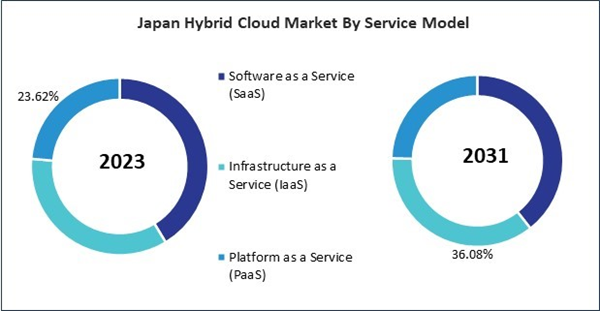The China market dominated the Asia Pacific Hybrid Cloud Market by Country in 2023, and would continue to be a dominant market till 2031; thereby, achieving a market value of $24.47 billion by 2031. Japan market is showcasing a CAGR of 16.7% during (2024 - 2031). Additionally, the India market would register a CAGR of 18.2% during (2024 - 2031).
Hybrid cloud solutions combine the strengths of public and private cloud infrastructures, allowing businesses to achieve a balanced approach that meets their unique needs. The applications of the hybrid cloud are diverse and impactful across various sectors.
Additionally, Hybrid cloud supports advanced business intelligence (BI) tools that can process data in real-time across both cloud and on-premises environments. This capability helps organizations make data-driven decisions quickly and accurately.
The rapid expansion of the telecommunications industry in China has led to the development of advanced network infrastructure, including widespread 5G deployment. This robust infrastructure supports the adoption of hybrid cloud solutions by providing reliable and high-speed connectivity essential for cloud operations. According to the State Council of the People’s Republic of China, the telecommunications industry in China logged steady expansion in 2022. Emerging businesses and new infrastructure rapidly grew the income of firms in the sector, topping 1.58 trillion yuan (233.38 billion U.S. dollars), up 8% year on year.
Based on Component, the market is segmented into Solution and Services. Based on Enterprise Size, the market is segmented into Small & Medium-sized Enterprises and Large Enterprises. Based on Service Model, the market is segmented into Software as a Service (SaaS), Infrastructure as a Service (IaaS), and Platform as a Service (PaaS). Based on Industry Vertical, the market is segmented into BFSI, IT & Telecom, Healthcare, Retail, Government, Media & Entertainment, Transportation & Logistics, Manufacturing, and Others. Based on countries, the market is segmented into China, Japan, India, South Korea, Singapore, Malaysia, and Rest of Asia Pacific.
List of Key Companies Profiled
- Amazon Web Services, Inc. (Amazon.com, Inc.)
- Microsoft Corporation
- Google LLC
- IBM Corporation
- Oracle Corporation
- SAP SE
- Salesforce, Inc.
- Dell Technologies, Inc.
- Equinix, Inc.
- Nutanix, Inc.
Market Report Segmentation
By Component
- Solution
- Services
By Enterprise Size
- Small & Medium-sized Enterprises
- Large Enterprises
By Service Model
- Software as a Service (SaaS)
- Infrastructure as a Service (IaaS)
- Platform as a Service (PaaS)
By Industry Vertical
- BFSI
- IT & Telecom
- Healthcare
- Retail
- Government
- Media & Entertainment
- Transportation & Logistics
- Manufacturing
- Others
By Country
- China
- Japan
- India
- South Korea
- Singapore
- Malaysia
- Rest of Asia Pacific
Table of Contents
Companies Mentioned
- Amazon Web Services, Inc. (Amazon.com, Inc.)
- Microsoft Corporation
- Google LLC
- IBM Corporation
- Oracle Corporation
- SAP SE
- Salesforce, Inc.
- Dell Technologies, Inc.
- Equinix, Inc.
- Nutanix, Inc.
Methodology

LOADING...









